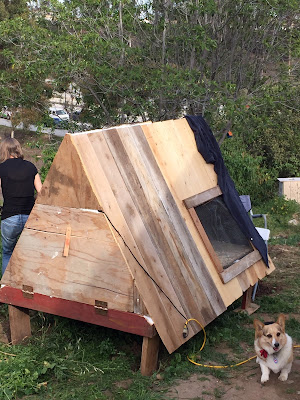In seed catalogs as early as 1894. In a paper for the Horticulture Department at Cornell University, R.W. Robinson opines that that the lemon cucumber may be the oldest cucumber cultivar in existence today.
 |
| A Young Lemon Cucumber |
The best way to enjoy this fruit is make it a part of your homegrown garden. But be forewarned, this plant can be delicate. It is prone to disease and often has a low yield. I've had troubles in the past. Because it is late blooming, I've lost plants to powdery mildew before picking fruit. Insects can wreck havoc on this plant too. You'll need a keen eye to catch problems before they become a death knell.
Train your plants up netting, or a trellis to save room in the garden as long as you have plenty of pollinating insects visiting your plants. I always trellis my cukes, I feel like I have a better eye on the pest and disease situation. Since I live in San Diego, where we rarely get rain in the summer, I planted my cucumbers right next to an olla watering vessel (A terracotta vessel under mostly underground that I fill with water to keep surrounding soil moist- more info in a later post).
Pick your lemon cucumbers as soon as they are a couple inches in diameter but no more than a 4" diameter. Not only will you run the risk of getting hard to eat seeds, but you'll be telling the plant to slow down fruit production-- So pick early and often.
Can you save the seeds from your lemon cucumbers? Short answer is, 'yes', with reservations. The Lemon Cucumber is an open pollinated seed. That means that it will cross with other cukes in the neighborhood. If you want a pure lemon cuke seed, be sure that you don't grow any other kinds of cukes, or if you have a big garden, be sure that your cucumber varieties are at least 1/2 mile apart. Or, if you are a seasoned savvy gardener, you can hand pollinate your plants (please do further research if you want to try). That being said, crossing with other cukes may not be so bad after all. It would be a gamble to cross pollinated seeds, but if you have the time, space, and desire- go for it. Leave the lemon cukes on the vine until over ripe. Then scoop out the seeds and slime, let the goo sit on the counter for a few days (think tomato seed saving process) to ferment. Mold and other icky green stuff may start growing. Stir the mixture frequently. Once the seeds settle on the bottom, and the slime is broken up, rinse off your seeds, let them fully dry on a plate, label and store for next year.
The Stats
Sowing: Directly in the Ground, 1" deep
Days to Maturity: 65-68
Water: Moist
Dirt: Normal, Well Drained, Loamy
Sun: Full
Genus: Curcumis
Species: Sativus
My Sources
Origin and Characterization of the 'Lemon' Cucumber by R.W. Robinson
Heirloom Cucumber Varieties by William Woys Weaver August 2013 for Mother Earth News
Buy the Seeds Here:
High Mowing- Organic and Non-GMO
Park Seed- Disease Resistant
Sustainable Seed Company- Certified Organic
Baker Creek Heirloom Seeds


















